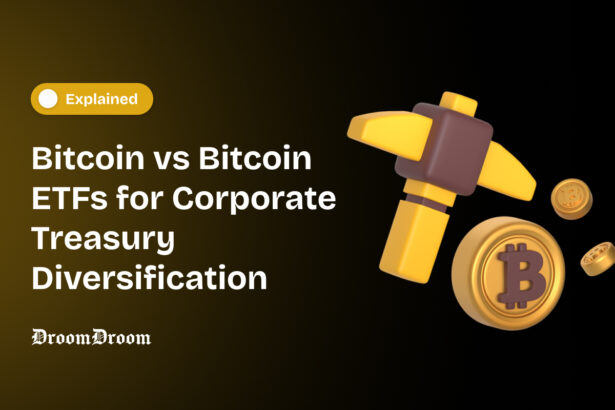Bitcoins have become mainstream with the creation of government reserves, corporate treasuries, and individual portfolios. Lately, there have emerged two key ways of investing in Bitcoin: either via an ETF, which provides a safer method, or via direct purchase, which provides far greater control over assets.
In this article, we will focus on different aspects of owning Bitcoins via ETFs and via direct holdings from a corporate standpoint.
At the end of this discussion, we aim to cover seven critical points that help companies and top investors decide which is the best investment medium for them.
10 Factors to Consider for a Company Before Building a Bitcoin Treasury
1. Custody
The first and most obvious difference is that ETFs take custody of a treasury’s Bitcoin in good faith (and by law), allowing them to benefit from it, without the hassle of maintenance and security.
However, ETFs might seize and hand over these assets to the government in the event of a dispute or any legal request from them. Here, the owner does not have absolute control over their asset.
Whereas, in the case of direct purchase, the Bitcoin Treasury itself is responsible for the safekeeping and management. They can either choose a custody partner like Coinbase Prime or Strategy or manage their own holdings like MARA Holdings.
How do Bitcoin Treasuries Manage Custody? Convenience vs Control
2. Security
As mentioned in the previous case, ETFs require treasuries to use custodians (because an ETF functions as a Trust, allowing direct custody would make them an exchange), while direct purchase allows them the flexibility to use both.
In the former case, security is often of the highest grade. Top custodians like Coinbase Prime, Bakkt, Fidelity Digital Assets, and others have multi-layered security consisting of deep cold storage vaults, multi-sig wallets, AI-enabled spam detection, firewalls to prevent server-overwhelming attacks, etc.
However, these security apparatuses often fail too, as seen in the ByBit Exchange hack ($1.4 billion lost) and LuBian ($3.5 billion lost).
Still, they are much safer than self-custodial solutions because they are more likely to have inexperienced employees.
3. Ease of Management
An ETF is obviously easier to manage as the custodian takes all the security risk, and the ETF issuer (i.e., the Trust) handles all the legal aspects. This mode of creating a Bitcoin Treasury is suitable for companies that lack experience in crypto asset management.
Direct purchases come with a lot of management overhead, such as setting up a secure digital vault, maintaining control of private keys, setting up multi-sig wallets to prevent single attacks draining all funds, and maintaining secure servers to allow easy transportation of funds.
AI Agent for Crypto Wallet Management: The Ultimate Guide to Seamless Crypto Transactions
4. Restrictions on Emergency Access
Access to the treasury funds is perhaps the most negative aspect of buying Bitcoin ETFs. Since ETF-based treasury funds are akin to shares, they can be frozen, seized, or attested by the government, courts, or any powerful public office. This leaves no choice for the treasury owner other than complying with government demands, even if they are inspired by malice.
Whereas in the case of direct Bitcoin holdings, there is no way a government or any centralized entity can seize or confiscate Bitcoins. As long as the user retains access to private keys, they own the Bitcoins in the address.
5. Legalities
In many countries, the legal status of Bitcoin is still debatable. Further, several countries are yet to form regulations around Bitcoin, especially with respect to taxation. In those markets, buying a Bitcoin ETF makes more sense because ETFs get similar tax treatment as shares in most nations. An example would be Yong Rong HK Asset Management in China, which owns Bitcoin ETFs as a part of its treasury diversification.
In countries where Bitcoin laws are more normalized, like the USA, the UK, and most EU countries, treasuries prefer to buy direct Bitcoin due to legal clarity.
6. Liquidity and Collateralization
An ETF is far less liquid than directly owning Bitcoins because of its acceptance. ETF buyers and sellers are far fewer in number and in transaction volume as compared to investors owning Bitcoin directly.
When raising funds, ETFs generally receive a lower sanction amount compared to direct Bitcoin transactions because of liquidity concerns. An ETF may or may not find a buyer in case the treasury needs to liquidate assets, whereas Bitcoin’s daily traded volume is at least $50 billion.
Further, to raise funds for further expansion, it is always easier for a lender to ask for Bitcoins as collateral rather than ETFs.
Below is a quick guide on how users can get a loan on their Bitcoins.
7. Fees and Commissions
The cost of maintaining an ETF-based treasury is far less than self-custody because ETFs spread security and management costs over all their customers, which lowers the fee paid by a single customer.
However, for maintaining a Bitcoin Treasury with direct BTC purchase, they have to hire the required technical staff or partner with a crypto custodian, which is still more expensive than an ETF.
Are Bitcoin Treasuries Heading Towards a Bubble like the Dot Com or Housing Crisis?




















